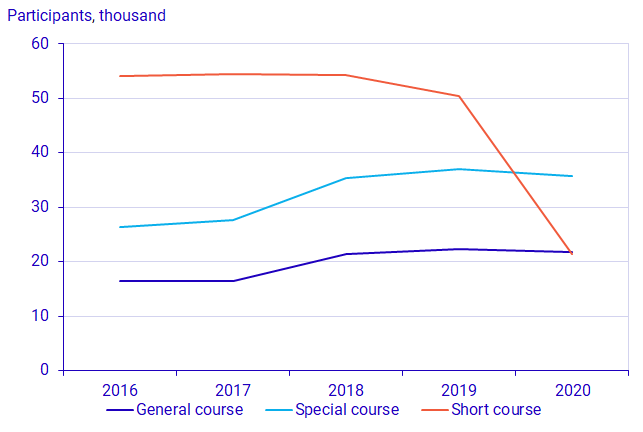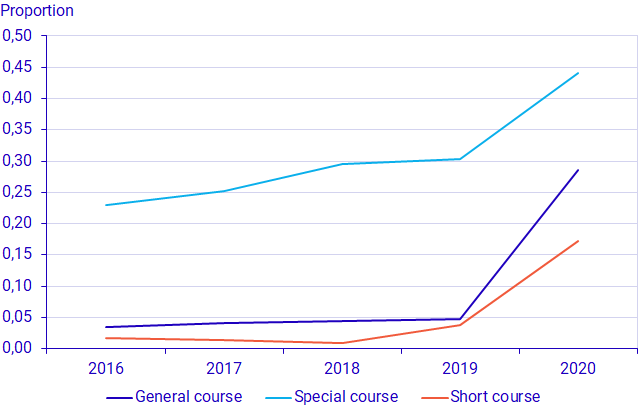Folk High School statistics 2020
Number of participants in folk high school short courses more than halved
Statistical news from Statistics Sweden 2021-03-30 9.30
The COVID-19 pandemic has had an impact on the general level of education. In 2020, only 20 000 people attended short courses at folk high school, compared with just over 50 000 in a normal year. In long courses, the number of participants remained the same. In long courses, many of the lessons transitioned to distance learning.
Short courses at folk high school refers to courses that are 1-15 days long and are offered in a wide range of subjects. In 2020, the largest drop in the number of participants was noted in courses in the social sciences and the arts. There were 60 percent fewer course participants than in 2019.
Short courses are often organised in collaboration with another operator such as a municipality or a study association. They are an important alternative to continuing education, especially for the older age group. Furthermore, the largest drop in the number of participants was noted in the older age groups.

There was no significant change in the number of participants in the folk high schools’ general and special courses compared with the last two years. About 22 000 unique participants attended the general course and just over 35 000 attended the special course in 2020.
Folk high schools’ general course is offered in all orientations. This type of course has an upper secondary level or basic level of difficulty. It is possible to study a single course, but it is also possible to study a general course to obtain eligibility for studies at post-secondary level.
Folk high schools’ special course is also offered in various orientations and levels of difficulty. However, compared to the general course, the main difference is that some special courses are offered at post-secondary level and that it is possible to obtain a certificate of completed post-secondary education. It is not possible to obtain other qualifications through studies at folk high school special courses.
Conversion to distance learning
Folk high schools, like other forms of education, have had to transition their scheduled lessons from in-person to distance learning. Not all courses were equally well suited to this change, so many short courses were cancelled instead.

Even before the pandemic, distance learning was fairly common in folk high schools’ special courses. A contributing factor is that many special courses are held at a post-secondary level and the structure may resemble teaching at universities. However, there was a clear increase in the proportion of course days with distance learning, from 30 percent in 2019 to 45 percent in 2020.
In general courses, distance learning was fairly uncommon before 2020, although it did occur. Before 2020, about 5 percent of the total number of course days was in the form of distance learning. In 2020, a large part of the teaching transitioned to distance learning over the course of the year, and overall, almost 3 in 10 course days were in the form of distance learning.
In the short courses, there was also a significant increase in the proportion of course days with distance learning, from 4 percent in 2019 to 17 percent in 2020. On the other hand, the number of course participants decreased significantly over the same period. The largest change in the short courses has thus been the cancellations.
Definitions and explanations
Admitted participants who have started their studies refers to all those who are attending or have attended at least one course, including those who have been added after the original start of the course and those who have interrupted their studies. Participants are counted for each program session and can therefore appear in the statistics two or more times in the same year. This means that the number of admitted participants who have started their studies is not the same as the number of people studying.
The number of course days differs significantly between different courses (from one day to an entire semester). Therefore, course days and participant weeks (the sum of all course days for all participants) are used to a greater extent than the number of students to calculate folk high schools’ activities.
A participant can attend several courses, within the same course type or different types of courses. This is why the term “unique participants” is used instead of simply participants. Each person is thus counted once, regardless of whether or not the person has participated in several courses. Studying several courses was most common among people attending short courses and least common among people attending special courses.
Feel free to use the facts from this statistical news but remember to state Source: Statistics Sweden.
